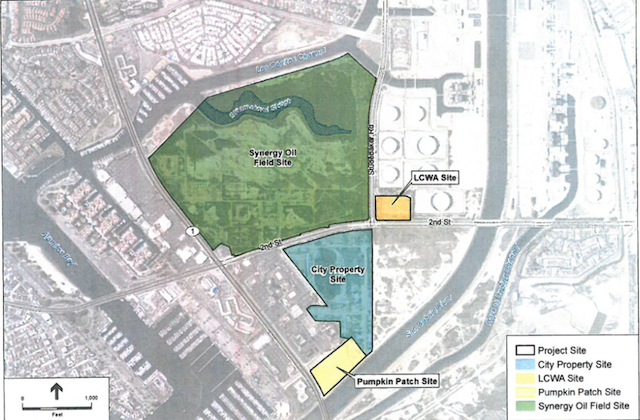The Long Beach City Planning Commission voted Thursday night to forward a final environmental impact report regarding the proposed land swap, oil consolidation project at the Los Cerritos Wetlands to the city council with a recommendation that the council also sign off on the finalized documents.
Titled the Los Cerritos Oil Consolidation and Wetlands Restoration Project, it would result in the city swapping land with an oil company—Beach Oil Minerals, LLC—which would create upward of 120 new oil wells on sites that currently serve as a seasonal pumpkin patch and a christmas tree lot as well as another that provides industrial storage.
In the land swap, some 52 wells would be eliminated over the course of 44 years with 150 acres of former oil fields being restored to wetlands and being transferred back into public ownership.

A shot of the project area from the presentation made to the planning commission.
However, the Los Cerritos Wetlands Authority (LCWA) site located at the northeast corner of the intersection of 2nd Street and Studebaker Road and the Pumpkin Patch site southeast of the intersection of 2nd Street and Pacific Coast Highway would see substantial amounts of new wells created as well as a 2,200-foot above ground pipeline that would connect the two sites.
The LCWA site would also get four new storage tanks, ranging from 35 feet to 50 feet in height, in addition to 70 new oil wells which will be drilled over the course of the first 15 years of the project. The tanks would have the capacity to store over 60,000 gallons of oil.
Some, including the LCWA, are in favor of the proposal because of the possibility to restore wetlands and return them to public ownership. Leaders from the LCWA and the Los Cerritos Wetlands Land Trust, an advocate group for the wetlands’ restoration, lauded Beach Oil Minerals for their transparency throughout the process that has spanned about four years now, with both stating they’re excited for the project to move forward.
“I’m old enough to remember that environmentalist and developers and everybody just communicated through lawyers and through pretty hardened positions,” said Elizabeth Lambe, executive director of the Los Cerritos Wetlands Land Trust. “It’s something that I feel has improved in the environmental movement, and that is when people talk to each other.”
Many others feel like the city is making a deal with the oil industry in a time when climate change science has suggested nations should cut back on their carbon footprints.
“If the rights of casual speculators to make a profit extracting the crude of a passing era trump the necessity of changing an antiquated form of existence in order to create a glowing sustainable future for the great majority of Long Beach residents and their progeny, then Mother Nature will continue to forcefully slap us down for our short-sided governance,” said Charles Moore, founder of the marine research group Algalita.
A large contingent of commenters voiced their opposition to the proposal with their grievances spanning from outright objection to extracting oil from the land, to Native American rights—parts of the project impact land previously inhabited by local tribes—to more practical concerns like earthquakes.
Steve Brothers, a Belmont Shore resident, cited a report published last year in The Los Angeles Times that revealed oil drilling may have triggered the Newport-Inglewood fault, which runs through the project area, and resulted in the 1933 earthquake—one that leveled buildings in Long Beach, and later became known as the Long Beach EarthquakeThe study focused only on earthquakes from 1900 to 1935 and did not make connections between oil drilling and more recent earthquakes. Representatives from the oil firm also noted that there would be no fracking—something that has been linked to earthquakes recently—at the proposed oil well sites.
However, if an earthquake occurs naturally along that fault it could compromise the oil facilities at the site. The Los Angeles Times also reported on a separate study released earlier this year that showed the Newport-Inglewood fault could be more dangerous than experts had previously believed.
To the point that many wanted the city to block the developers from extracting oil altogether, Assistant City Attorney Mike Mais noted that while in some cases the city can block the drilling of new wells, it has deemed the project site permissible for drilling in the city’s oil code. But even if the city were to change it, Synergy, and now Beach Oil Minerals group, would retain the mineral rights to the oil located on the site regardless if they access it from the Pumpkin Patch site or from their current well locations.
The developers have pledged that the updated technology will make the operations safer and cleaner, with the bulk of the unavoidable emission increases occurring during the construction periods of the project, which could be spaced out over the next few decades.
Now that the EIR has been forwarded to the city council it does not mean that the council’s vote will be the last obstacle for it to move forward. Because of its location in the coastal zone and the drilling of oil wells it will require further approval from multiple state and federal agencies including the California Coastal Commission and the United States Army Corp of Engineers.
The wetlands project is connected to a separate rezoning effort by the city which is trying to update its land use plan for the former Southeast Area Specific Plan SEADIP area. In September it voted to approve changes to SEADIP—now SEASP—to create room for more density in regard to housing, but also to reclassify some of the land like the Pumpkin Patch site to industrial, something necessary for the land swap with the Beach Oil Minerals group to go forward.
That SEASP vote is being challenged in court.

